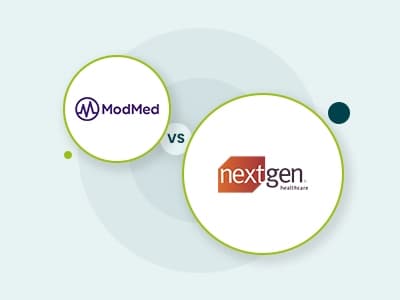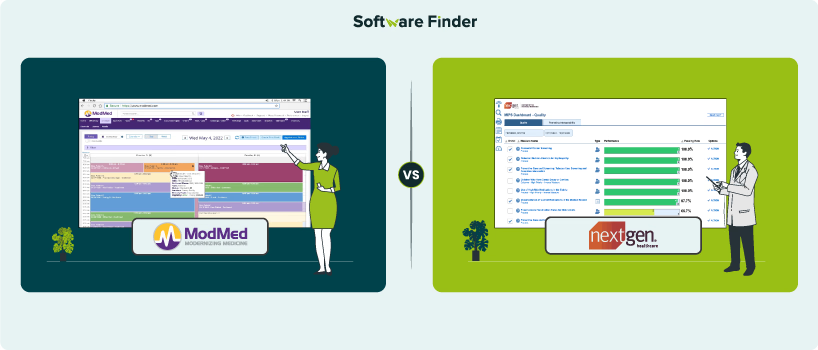
Monthly Price: Starting from $799/provider/month* Best For: Podiatry, Orthopedics, OBGYN Mobile App: iOS, Android Rating: 4.1/5 *The pricing has been sourced from third-party websites and is subject to change | Monthly Price: Custom Pricing Best For: Behavioral Health, Cardiology Mobile App: iOS, Android Rating: 3.9/5 |
The electronic health records (EHR) industry has grown exponentially over the past few years. It offers a wide range of tools for practices of all sizes and specialties. For many providers, the challenge doesn’t only lie in adopting the technology, but also in finding the right system that fits their clinical and administrative workflows.
Among the most talked-about names in this space are ModMed and NextGen. These two platforms offer distinct features and capabilities that cater to various types of healthcare organizations. While both aim to streamline operations and improve care delivery, they differ in how they handle specialty-specific needs, patient engagement, and overall usability.
This comparison of MedMod vs NextGen looks at their key features, pricing, and user experiences to help you evaluate which system aligns better with your practice needs.
ModMed EMR is a specialty-specific, cloud-based platform designed to adapt to a practitioner’s unique workflow. It aims to enhance clinical, financial, and operational efficiency by streamlining tasks like scheduling, billing, and patient communication. ModMed offers various tools such as AI documentation, reporting, analytics, and billing.
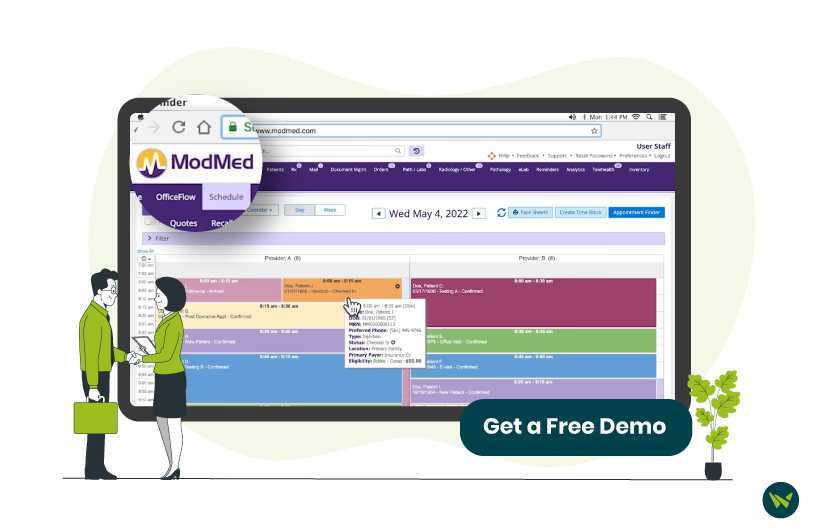
In contrast, NextGen Healthcare offers two product suites - NextGen Enterprise EHR which is built for larger medical groups, multi-specialty organizations, and health systems. It offers highly customizable templates, advanced analytics, and population health management.
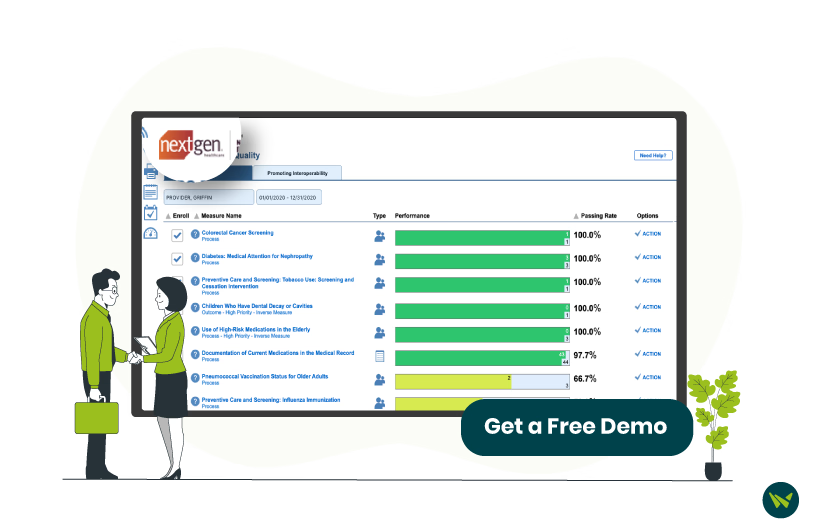
Meanwhile, NextGen Office EHR is designed for small to mid-sized practices to support coordinated, efficient care delivery across specialties. It provides tools for clinical documentation, integrated telehealth, and automated revenue cycle workflows.
| Feature | ModMed | NextGen |
| Practice Management | ✓ | ✓ |
| Revenue Cycle Management | ✓ | ✓ |
| Voice Recognition | ✓ | ✓ |
| Interoperability | ✓ | ✓ |
| Telehealth | ✓ | ✓ |
| AI Capabilities | ✓ | ✓ |
| Predictive Scheduler | ✓ | ✓ |
| Integrated Clearinghouse | ✓ | ✓ |
| ModMed | NextGen |
Pros: Reduces coding errors with built-in ICD-10 support Saves time through fast, intuitive scheduling tools Promotes better outcomes with streamlined care delivery Cons: Limited billing functionality May not easily connect with the patient reminder system | Pros: Seamless navigation from charts to medication Flexible and customizable patient templates Streamlined and integrated billing system Cons: Customization may take time Response time of the support team can be slow |
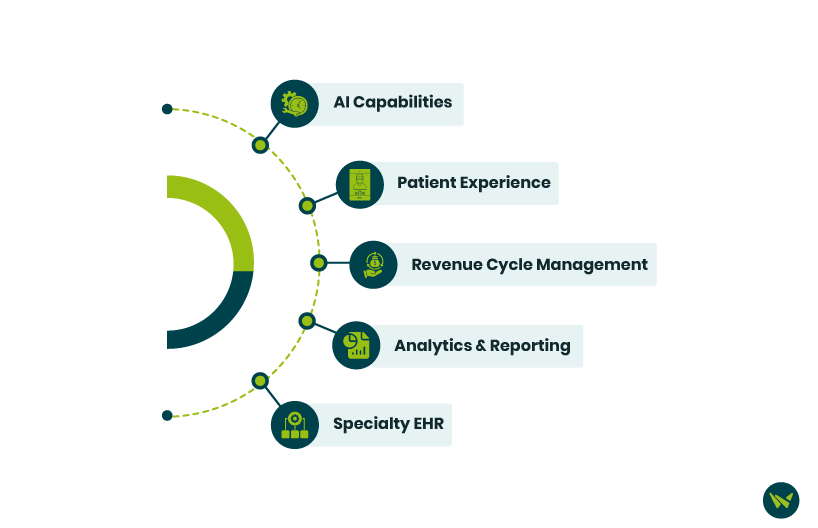

ModMed offers a flexible pricing structure that depends on the practice’s size and number of users. The plans may include:
- Small Practices - $799/provider/month
- Medium to Large Practices - $999/provider/month to $1,299/provider/month
Disclaimer: The pricing has been sourced from third-party websites and is subject to change.
On the other hand, NextGen offers a customizable pricing model tailored to the specific needs of practitioners. The plans are based on various factors such as practice size, features, functionalities, and other requirements of healthcare organizations.
Overall, ModMed offers a more transparent pricing structure. But if you are looking for an EHR with a flexible approach toward plans, then NextGen Office might be a better fit for you.
Users highlight different strengths and weaknesses of both ModMed and NextGen. ModMed is praised for its intuitive interface and specialty-specific design. It is also commended for its ability to streamline workflows, particularly through its iPad-based interface and real-time documentation capabilities. It is also appreciated for its built-in coding support, intuitive scheduling tools, and fast documentation.
However, some users have also pointed out some drawbacks by highlighting its limited billing functionalities and errors in connecting seamlessly with the patient reminder system.
In comparison, NextGen receives recognition for its customization capabilities and adaptable structure for multi-specialty and ambulatory practices. Many users note that the system supports extensive template customization and offers strong interoperability. One physician states,
“We use this system for our electronic medical records and have found it to be user-friendly, files are easy to create and access, and customer service is helpful as needed.”
On the downside, some users have expressed concerns regarding excessive clicks and workflow interruption. At the same time, others have faced challenges when integrating the software with billing and scheduling.
Both ModMed and NextGen bring considerable value to clinical practices; however, they serve slightly different operational needs.
ModMed stands out with its specialty-specific design, deeply integrated revenue cycle tools, and intuitive, mobile-friendly workflows that suit specialty-focused practices. Its AI capabilities, documentation, and adaptive learning streamlines clinical workflows for practices of all sizes.
NextGen, on the other hand, offers broader specialty coverage, enterprise-grade analytics, and efficient patient engagement tools. It is an ideal solution for multi-specialty practices of all sizes, particularly those that prioritize scalability, customizable templates, and data-driven decision-making across broader networks.
Ultimately, the decision depends on your practice size, specialty, feature requirements, and budget.
